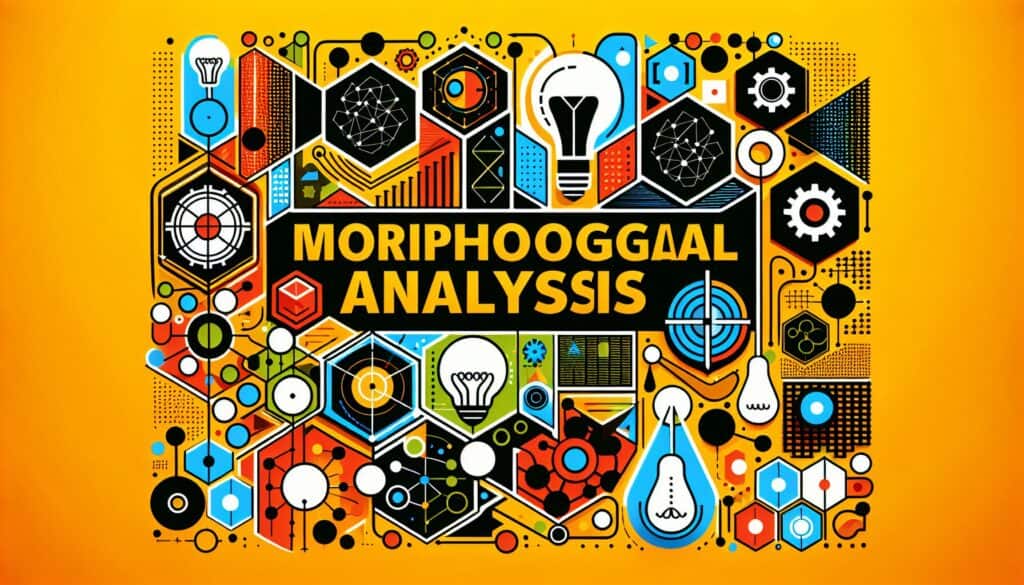Eine Problemlösungs- und Ideenfindungstechnik, bei der ein komplexes Problem oder System in seine grundlegenden Parameter oder Dimensionen zerlegt wird, um dann alle möglichen Kombinationen dieser Parameter zu generieren und neue Lösungen zu finden.
- Methodologien: Kunden & Marketing, Ideenfindung, Produktdesign
Morphologische Analyse

Morphologische Analyse
- Kreativität, Design für additive Fertigung (DfAM), Optimierung des Designs, Design Denken, Ideenfindung, Innovation, Problemlösungs-Techniken, Systemmodellierungssprache (SysML), Wertanalyse (VE)
Zielsetzung:
Wie es verwendet wird:
- Identifiziert die wichtigsten Merkmale oder Funktionen eines Produkts/Problems. Für jedes Merkmal wird eine Liste möglicher Varianten oder Implementierungen erstellt. Die Kombinationen dieser Varianten werden dann systematisch untersucht.
Vorteile
- Bietet eine systematische Möglichkeit, ein breites Spektrum potenzieller Lösungen oder Konfigurationen zu untersuchen; kann zu innovativen und unerwarteten Ideen führen; trägt dazu bei, dass alle Möglichkeiten berücksichtigt werden.
Nachteile
- Kann sehr komplex werden und eine überwältigende Anzahl von Kombinationen erzeugen, wenn es viele Parameter oder Varianten gibt; die Auswertung aller Kombinationen kann unpraktisch sein; erfordert eine klare Definition der Parameter.
Kategorien:
- Ideenfindung, Problemlösung, Produktdesign
Am besten geeignet für:
- Systematische Strukturierung und Erkundung aller möglichen Lösungen für ein komplexes Problem, indem es in seine Kerndimensionen zerlegt wird und Kombinationen entstehen.
Morphological Analysis is frequently utilized in industries such as automotive design, aerospace engineering, and consumer electronics, where the intricacies of product features and functions necessitate thorough examination. During the conceptual phase of projects, teams typically comprising engineers, designers, and product managers initiate this methodology to dissect the multifaceted nature of challenges they face. By identifying the fundamental features of a product or problem, such as size, material, or functionality, and generating variations for each, teams can explore a vast array of combinations that might lead to groundbreaking solutions. For example, in automotive design, variations might include different types of propulsion systems (electric, hybrid, traditional combustion) combined with varied body styles (sedan, SUV, coupe), which can yield numerous innovative vehicle concepts. This structured exploration fosters creativity, facilitating the emergence of previously unconsidered solutions that enhance product appeal while addressing user needs or environmental concerns. Workshops and collaborative sessions are often organized around this methodology, allowing diverse input and interdisciplinary cooperation, which not only broadens the exploration process but also aligns the team’s focus on achievable, coherent outcomes.
Die wichtigsten Schritte dieser Methodik
- Identify the core dimensions of the problem or product.
- Define key features or functions related to each dimension.
- Generate a comprehensive list of possible variations for each feature.
- Create a morphological matrix to combine variations systematically.
- Explore different configurations by analyzing the matrix.
- Select and evaluate promising combinations for feasibility and relevance.
- Refine configurations based on feedback and insights gained.
- Document the selected combinations for further development and prototyping.
Profi-Tipps
- Utilize clustering techniques during the variation generation phase to identify synergies among features, enabling stronger combinations that may not be immediately apparent.
- Integrate feedback loops from stakeholders at various stages of the analysis to validate and refine the combinations, ensuring relevance and applicability to real-world scenarios.
- Employ simulation tools to visualize and test the feasibility of the selected combinations, allowing for quicker iterations and adjustments before moving to physical prototypes.
Verschiedene Methoden lesen und vergleichen, Wir empfehlen die
> Umfassendes Methoden-Repository <
zusammen mit den über 400 anderen Methoden.
Ihre Kommentare zu dieser Methodik oder zusätzliche Informationen sind willkommen auf der Kommentarbereich unten ↓ , sowie alle ingenieursbezogenen Ideen oder Links.
Historischer Kontext
1949
1950
1950
1960
1960
1960
1960
1940
1950
1950
1958
1960
1960
1960
1960
(wenn das Datum nicht bekannt oder nicht relevant ist, z. B. "Strömungsmechanik", wird eine gerundete Schätzung des bemerkenswerten Erscheinens angegeben)















Verwandte Artikel
Fragebögen zu muskuloskelettalen Beschwerden
Multivariate Tests (MVT)
Mehrfache Regressionsanalyse
Motion-Capture-Systeme
MoSCoW-Methode
Moods Median-Test